Assessing Occupational Competence in Work Environment - Level 3 Unit 2
VerifiedAdded on 2022/10/11
|5
|1693
|301
Practical Assignment
AI Summary
This assignment focuses on Unit 2: Assess Occupational Competence in the Work Environment, a Level 3 practical application unit. It covers planning assessments using various methods like observation, examining work, questioning, and witness testimony. The assignment emphasizes communicating assessment purposes, addressing learner needs, and identifying holistic assessment opportunities. It also delves into making assessment decisions, using valid methods, and following standardization procedures. Furthermore, it highlights the importance of providing feedback, maintaining records, and adhering to legal and good practice requirements, including equality, diversity, and health and safety regulations. The assignment also provides references to support the content.
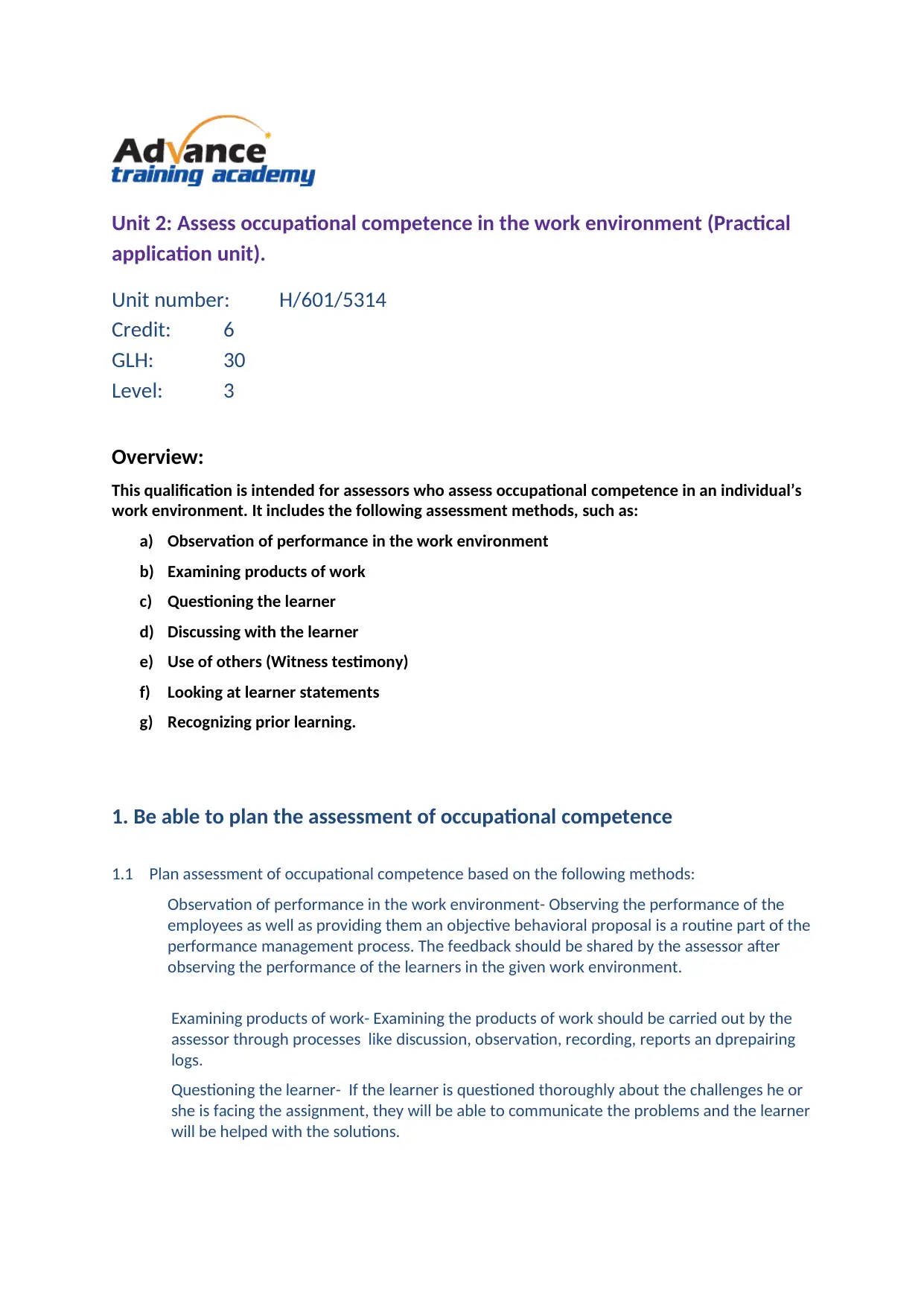
Unit 2: Assess occupational competence in the work environment (Practical
application unit).
Unit number: H/601/5314
Credit: 6
GLH: 30
Level: 3
Overview:
This qualification is intended for assessors who assess occupational competence in an individual’s
work environment. It includes the following assessment methods, such as:
a) Observation of performance in the work environment
b) Examining products of work
c) Questioning the learner
d) Discussing with the learner
e) Use of others (Witness testimony)
f) Looking at learner statements
g) Recognizing prior learning.
1. Be able to plan the assessment of occupational competence
1.1 Plan assessment of occupational competence based on the following methods:
Observation of performance in the work environment- Observing the performance of the
employees as well as providing them an objective behavioral proposal is a routine part of the
performance management process. The feedback should be shared by the assessor after
observing the performance of the learners in the given work environment.
Examining products of work- Examining the products of work should be carried out by the
assessor through processes like discussion, observation, recording, reports an dprepairing
logs.
Questioning the learner- If the learner is questioned thoroughly about the challenges he or
she is facing the assignment, they will be able to communicate the problems and the learner
will be helped with the solutions.
application unit).
Unit number: H/601/5314
Credit: 6
GLH: 30
Level: 3
Overview:
This qualification is intended for assessors who assess occupational competence in an individual’s
work environment. It includes the following assessment methods, such as:
a) Observation of performance in the work environment
b) Examining products of work
c) Questioning the learner
d) Discussing with the learner
e) Use of others (Witness testimony)
f) Looking at learner statements
g) Recognizing prior learning.
1. Be able to plan the assessment of occupational competence
1.1 Plan assessment of occupational competence based on the following methods:
Observation of performance in the work environment- Observing the performance of the
employees as well as providing them an objective behavioral proposal is a routine part of the
performance management process. The feedback should be shared by the assessor after
observing the performance of the learners in the given work environment.
Examining products of work- Examining the products of work should be carried out by the
assessor through processes like discussion, observation, recording, reports an dprepairing
logs.
Questioning the learner- If the learner is questioned thoroughly about the challenges he or
she is facing the assignment, they will be able to communicate the problems and the learner
will be helped with the solutions.
Paraphrase This Document
Need a fresh take? Get an instant paraphrase of this document with our AI Paraphraser
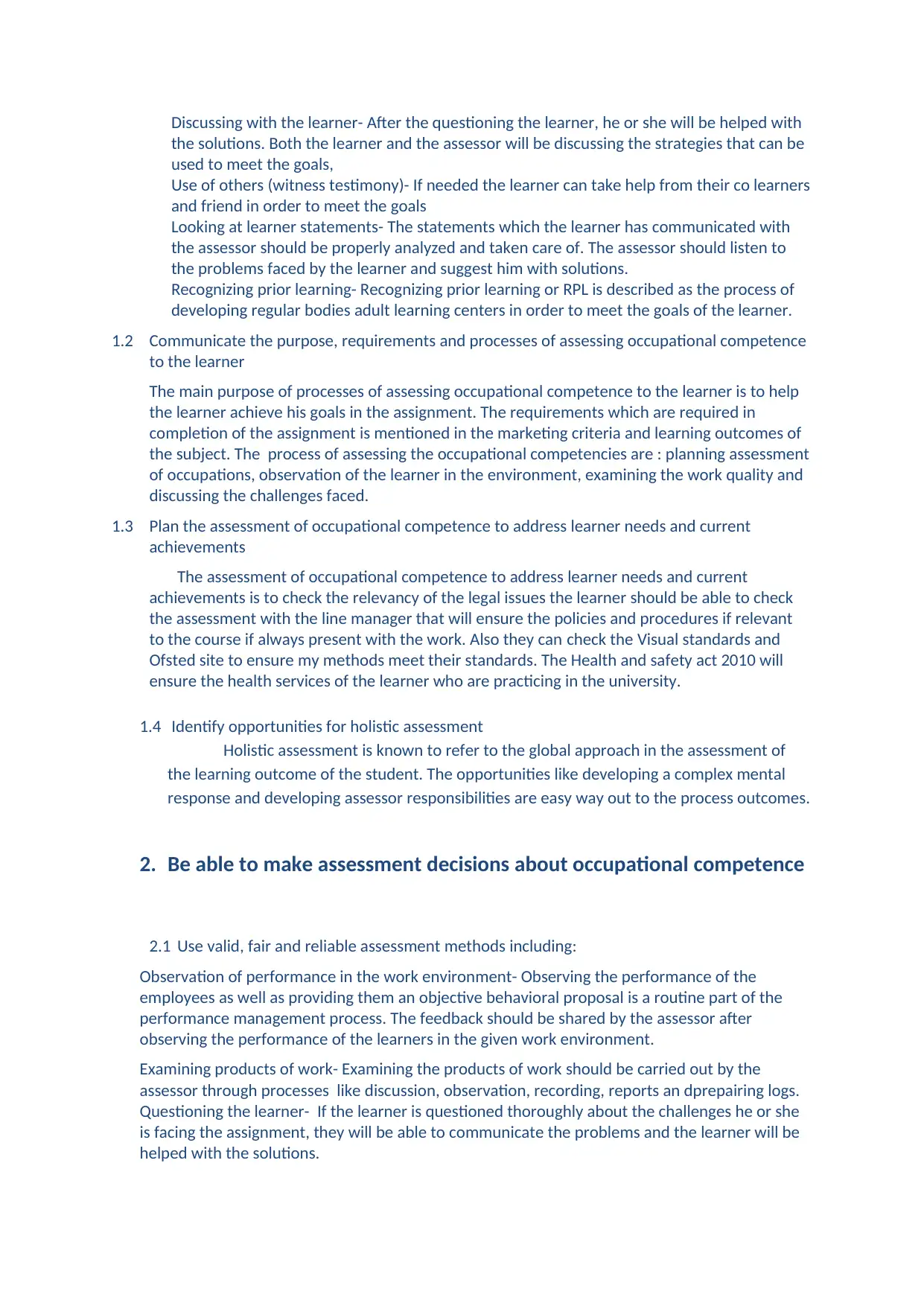
Discussing with the learner- After the questioning the learner, he or she will be helped with
the solutions. Both the learner and the assessor will be discussing the strategies that can be
used to meet the goals,
Use of others (witness testimony)- If needed the learner can take help from their co learners
and friend in order to meet the goals
Looking at learner statements- The statements which the learner has communicated with
the assessor should be properly analyzed and taken care of. The assessor should listen to
the problems faced by the learner and suggest him with solutions.
Recognizing prior learning- Recognizing prior learning or RPL is described as the process of
developing regular bodies adult learning centers in order to meet the goals of the learner.
1.2 Communicate the purpose, requirements and processes of assessing occupational competence
to the learner
The main purpose of processes of assessing occupational competence to the learner is to help
the learner achieve his goals in the assignment. The requirements which are required in
completion of the assignment is mentioned in the marketing criteria and learning outcomes of
the subject. The process of assessing the occupational competencies are : planning assessment
of occupations, observation of the learner in the environment, examining the work quality and
discussing the challenges faced.
1.3 Plan the assessment of occupational competence to address learner needs and current
achievements
The assessment of occupational competence to address learner needs and current
achievements is to check the relevancy of the legal issues the learner should be able to check
the assessment with the line manager that will ensure the policies and procedures if relevant
to the course if always present with the work. Also they can check the Visual standards and
Ofsted site to ensure my methods meet their standards. The Health and safety act 2010 will
ensure the health services of the learner who are practicing in the university.
1.4 Identify opportunities for holistic assessment
Holistic assessment is known to refer to the global approach in the assessment of
the learning outcome of the student. The opportunities like developing a complex mental
response and developing assessor responsibilities are easy way out to the process outcomes.
2. Be able to make assessment decisions about occupational competence
2.1 Use valid, fair and reliable assessment methods including:
Observation of performance in the work environment- Observing the performance of the
employees as well as providing them an objective behavioral proposal is a routine part of the
performance management process. The feedback should be shared by the assessor after
observing the performance of the learners in the given work environment.
Examining products of work- Examining the products of work should be carried out by the
assessor through processes like discussion, observation, recording, reports an dprepairing logs.
Questioning the learner- If the learner is questioned thoroughly about the challenges he or she
is facing the assignment, they will be able to communicate the problems and the learner will be
helped with the solutions.
the solutions. Both the learner and the assessor will be discussing the strategies that can be
used to meet the goals,
Use of others (witness testimony)- If needed the learner can take help from their co learners
and friend in order to meet the goals
Looking at learner statements- The statements which the learner has communicated with
the assessor should be properly analyzed and taken care of. The assessor should listen to
the problems faced by the learner and suggest him with solutions.
Recognizing prior learning- Recognizing prior learning or RPL is described as the process of
developing regular bodies adult learning centers in order to meet the goals of the learner.
1.2 Communicate the purpose, requirements and processes of assessing occupational competence
to the learner
The main purpose of processes of assessing occupational competence to the learner is to help
the learner achieve his goals in the assignment. The requirements which are required in
completion of the assignment is mentioned in the marketing criteria and learning outcomes of
the subject. The process of assessing the occupational competencies are : planning assessment
of occupations, observation of the learner in the environment, examining the work quality and
discussing the challenges faced.
1.3 Plan the assessment of occupational competence to address learner needs and current
achievements
The assessment of occupational competence to address learner needs and current
achievements is to check the relevancy of the legal issues the learner should be able to check
the assessment with the line manager that will ensure the policies and procedures if relevant
to the course if always present with the work. Also they can check the Visual standards and
Ofsted site to ensure my methods meet their standards. The Health and safety act 2010 will
ensure the health services of the learner who are practicing in the university.
1.4 Identify opportunities for holistic assessment
Holistic assessment is known to refer to the global approach in the assessment of
the learning outcome of the student. The opportunities like developing a complex mental
response and developing assessor responsibilities are easy way out to the process outcomes.
2. Be able to make assessment decisions about occupational competence
2.1 Use valid, fair and reliable assessment methods including:
Observation of performance in the work environment- Observing the performance of the
employees as well as providing them an objective behavioral proposal is a routine part of the
performance management process. The feedback should be shared by the assessor after
observing the performance of the learners in the given work environment.
Examining products of work- Examining the products of work should be carried out by the
assessor through processes like discussion, observation, recording, reports an dprepairing logs.
Questioning the learner- If the learner is questioned thoroughly about the challenges he or she
is facing the assignment, they will be able to communicate the problems and the learner will be
helped with the solutions.
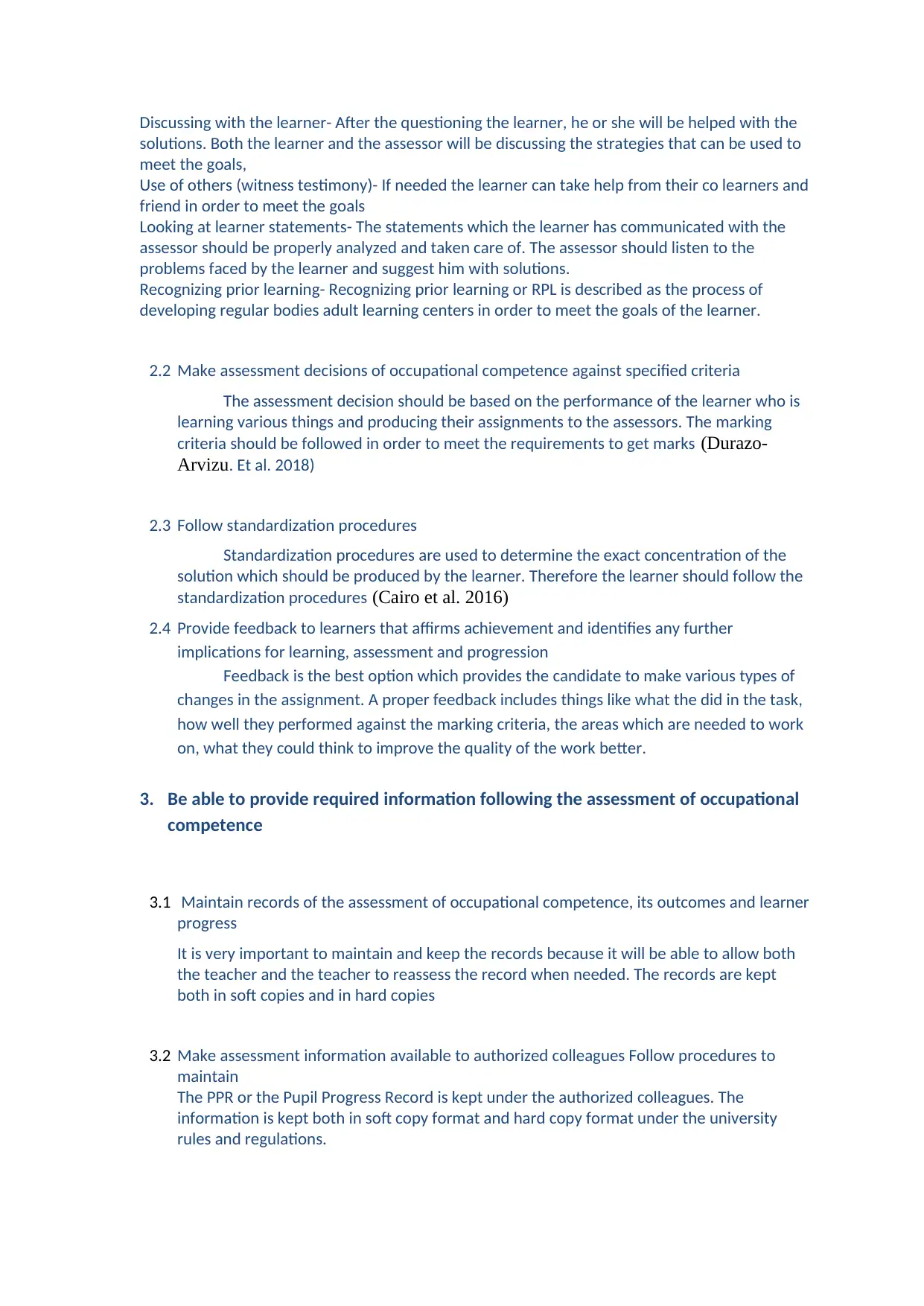
Discussing with the learner- After the questioning the learner, he or she will be helped with the
solutions. Both the learner and the assessor will be discussing the strategies that can be used to
meet the goals,
Use of others (witness testimony)- If needed the learner can take help from their co learners and
friend in order to meet the goals
Looking at learner statements- The statements which the learner has communicated with the
assessor should be properly analyzed and taken care of. The assessor should listen to the
problems faced by the learner and suggest him with solutions.
Recognizing prior learning- Recognizing prior learning or RPL is described as the process of
developing regular bodies adult learning centers in order to meet the goals of the learner.
2.2 Make assessment decisions of occupational competence against specified criteria
The assessment decision should be based on the performance of the learner who is
learning various things and producing their assignments to the assessors. The marking
criteria should be followed in order to meet the requirements to get marks (Durazo-
Arvizu. Et al. 2018)
2.3 Follow standardization procedures
Standardization procedures are used to determine the exact concentration of the
solution which should be produced by the learner. Therefore the learner should follow the
standardization procedures (Cairo et al. 2016)
2.4 Provide feedback to learners that affirms achievement and identifies any further
implications for learning, assessment and progression
Feedback is the best option which provides the candidate to make various types of
changes in the assignment. A proper feedback includes things like what the did in the task,
how well they performed against the marking criteria, the areas which are needed to work
on, what they could think to improve the quality of the work better.
3. Be able to provide required information following the assessment of occupational
competence
3.1 Maintain records of the assessment of occupational competence, its outcomes and learner
progress
It is very important to maintain and keep the records because it will be able to allow both
the teacher and the teacher to reassess the record when needed. The records are kept
both in soft copies and in hard copies
3.2 Make assessment information available to authorized colleagues Follow procedures to
maintain
The PPR or the Pupil Progress Record is kept under the authorized colleagues. The
information is kept both in soft copy format and hard copy format under the university
rules and regulations.
solutions. Both the learner and the assessor will be discussing the strategies that can be used to
meet the goals,
Use of others (witness testimony)- If needed the learner can take help from their co learners and
friend in order to meet the goals
Looking at learner statements- The statements which the learner has communicated with the
assessor should be properly analyzed and taken care of. The assessor should listen to the
problems faced by the learner and suggest him with solutions.
Recognizing prior learning- Recognizing prior learning or RPL is described as the process of
developing regular bodies adult learning centers in order to meet the goals of the learner.
2.2 Make assessment decisions of occupational competence against specified criteria
The assessment decision should be based on the performance of the learner who is
learning various things and producing their assignments to the assessors. The marking
criteria should be followed in order to meet the requirements to get marks (Durazo-
Arvizu. Et al. 2018)
2.3 Follow standardization procedures
Standardization procedures are used to determine the exact concentration of the
solution which should be produced by the learner. Therefore the learner should follow the
standardization procedures (Cairo et al. 2016)
2.4 Provide feedback to learners that affirms achievement and identifies any further
implications for learning, assessment and progression
Feedback is the best option which provides the candidate to make various types of
changes in the assignment. A proper feedback includes things like what the did in the task,
how well they performed against the marking criteria, the areas which are needed to work
on, what they could think to improve the quality of the work better.
3. Be able to provide required information following the assessment of occupational
competence
3.1 Maintain records of the assessment of occupational competence, its outcomes and learner
progress
It is very important to maintain and keep the records because it will be able to allow both
the teacher and the teacher to reassess the record when needed. The records are kept
both in soft copies and in hard copies
3.2 Make assessment information available to authorized colleagues Follow procedures to
maintain
The PPR or the Pupil Progress Record is kept under the authorized colleagues. The
information is kept both in soft copy format and hard copy format under the university
rules and regulations.
⊘ This is a preview!⊘
Do you want full access?
Subscribe today to unlock all pages.

Trusted by 1+ million students worldwide
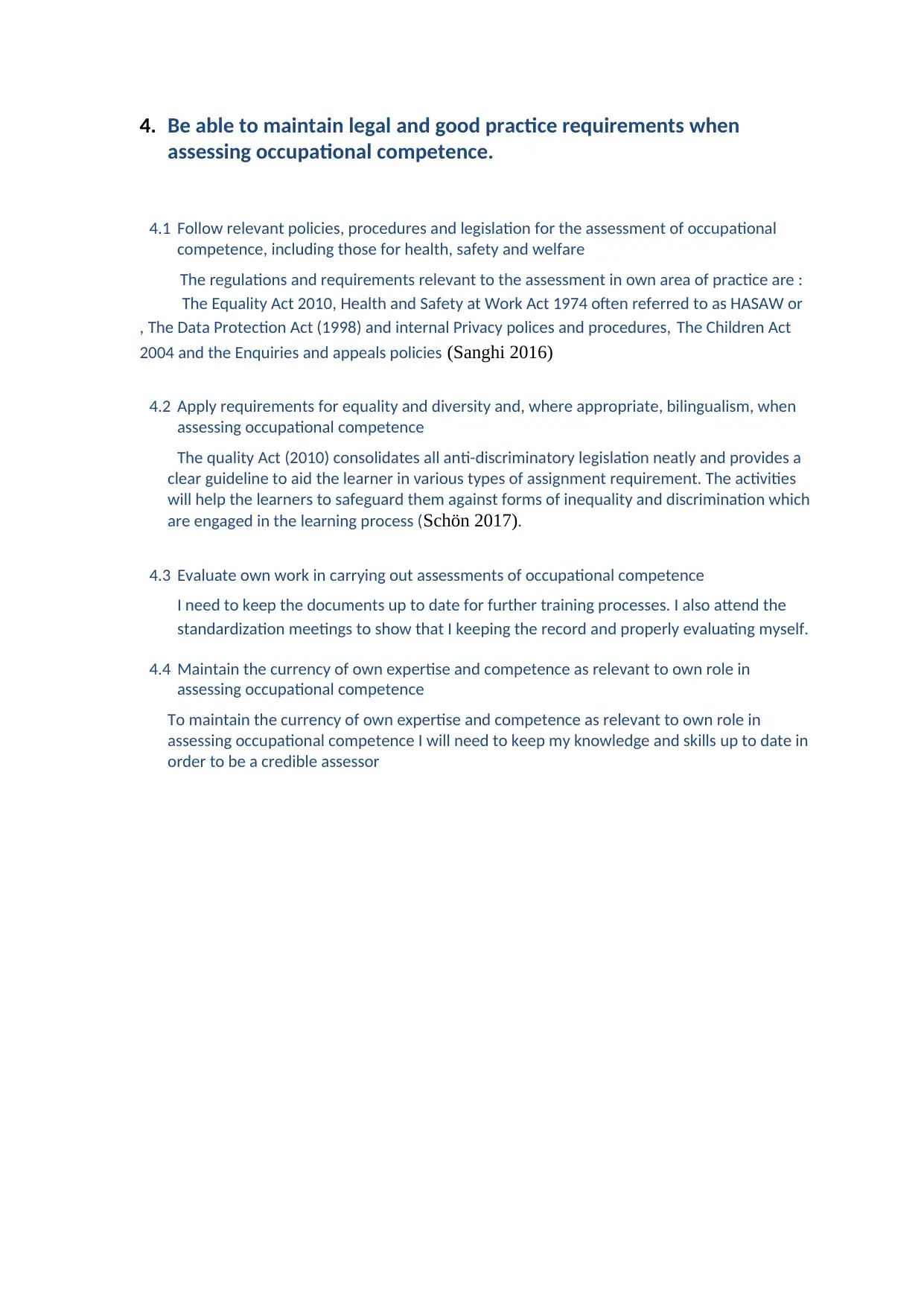
4. Be able to maintain legal and good practice requirements when
assessing occupational competence.
4.1 Follow relevant policies, procedures and legislation for the assessment of occupational
competence, including those for health, safety and welfare
The regulations and requirements relevant to the assessment in own area of practice are :
The Equality Act 2010, Health and Safety at Work Act 1974 often referred to as HASAW or
, The Data Protection Act (1998) and internal Privacy polices and procedures, The Children Act
2004 and the Enquiries and appeals policies (Sanghi 2016)
4.2 Apply requirements for equality and diversity and, where appropriate, bilingualism, when
assessing occupational competence
The quality Act (2010) consolidates all anti-discriminatory legislation neatly and provides a
clear guideline to aid the learner in various types of assignment requirement. The activities
will help the learners to safeguard them against forms of inequality and discrimination which
are engaged in the learning process (Schön 2017).
4.3 Evaluate own work in carrying out assessments of occupational competence
I need to keep the documents up to date for further training processes. I also attend the
standardization meetings to show that I keeping the record and properly evaluating myself.
4.4 Maintain the currency of own expertise and competence as relevant to own role in
assessing occupational competence
To maintain the currency of own expertise and competence as relevant to own role in
assessing occupational competence I will need to keep my knowledge and skills up to date in
order to be a credible assessor
assessing occupational competence.
4.1 Follow relevant policies, procedures and legislation for the assessment of occupational
competence, including those for health, safety and welfare
The regulations and requirements relevant to the assessment in own area of practice are :
The Equality Act 2010, Health and Safety at Work Act 1974 often referred to as HASAW or
, The Data Protection Act (1998) and internal Privacy polices and procedures, The Children Act
2004 and the Enquiries and appeals policies (Sanghi 2016)
4.2 Apply requirements for equality and diversity and, where appropriate, bilingualism, when
assessing occupational competence
The quality Act (2010) consolidates all anti-discriminatory legislation neatly and provides a
clear guideline to aid the learner in various types of assignment requirement. The activities
will help the learners to safeguard them against forms of inequality and discrimination which
are engaged in the learning process (Schön 2017).
4.3 Evaluate own work in carrying out assessments of occupational competence
I need to keep the documents up to date for further training processes. I also attend the
standardization meetings to show that I keeping the record and properly evaluating myself.
4.4 Maintain the currency of own expertise and competence as relevant to own role in
assessing occupational competence
To maintain the currency of own expertise and competence as relevant to own role in
assessing occupational competence I will need to keep my knowledge and skills up to date in
order to be a credible assessor
Paraphrase This Document
Need a fresh take? Get an instant paraphrase of this document with our AI Paraphraser
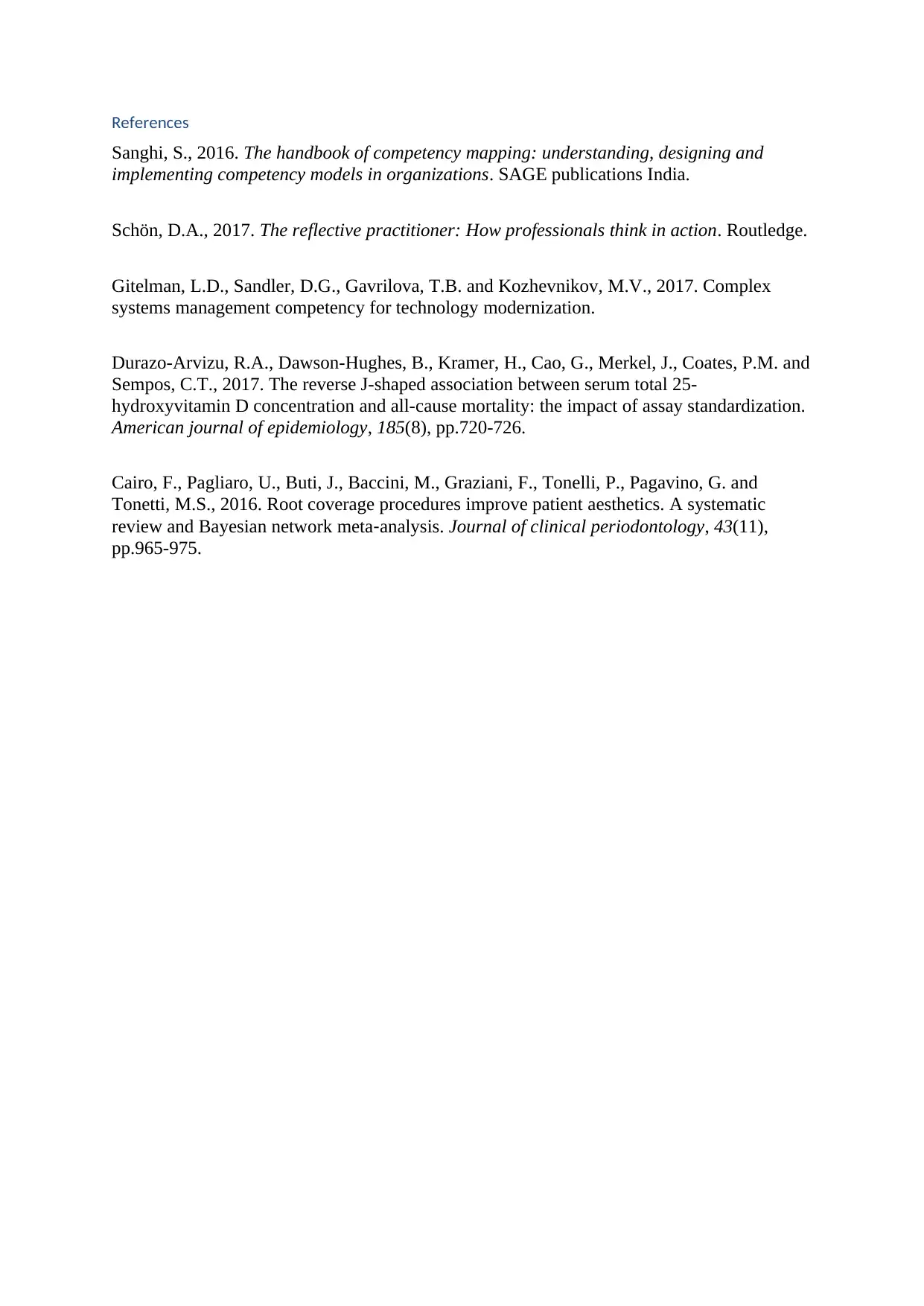
References
Sanghi, S., 2016. The handbook of competency mapping: understanding, designing and
implementing competency models in organizations. SAGE publications India.
Schön, D.A., 2017. The reflective practitioner: How professionals think in action. Routledge.
Gitelman, L.D., Sandler, D.G., Gavrilova, T.B. and Kozhevnikov, M.V., 2017. Complex
systems management competency for technology modernization.
Durazo-Arvizu, R.A., Dawson-Hughes, B., Kramer, H., Cao, G., Merkel, J., Coates, P.M. and
Sempos, C.T., 2017. The reverse J-shaped association between serum total 25-
hydroxyvitamin D concentration and all-cause mortality: the impact of assay standardization.
American journal of epidemiology, 185(8), pp.720-726.
Cairo, F., Pagliaro, U., Buti, J., Baccini, M., Graziani, F., Tonelli, P., Pagavino, G. and
Tonetti, M.S., 2016. Root coverage procedures improve patient aesthetics. A systematic
review and Bayesian network meta‐analysis. Journal of clinical periodontology, 43(11),
pp.965-975.
Sanghi, S., 2016. The handbook of competency mapping: understanding, designing and
implementing competency models in organizations. SAGE publications India.
Schön, D.A., 2017. The reflective practitioner: How professionals think in action. Routledge.
Gitelman, L.D., Sandler, D.G., Gavrilova, T.B. and Kozhevnikov, M.V., 2017. Complex
systems management competency for technology modernization.
Durazo-Arvizu, R.A., Dawson-Hughes, B., Kramer, H., Cao, G., Merkel, J., Coates, P.M. and
Sempos, C.T., 2017. The reverse J-shaped association between serum total 25-
hydroxyvitamin D concentration and all-cause mortality: the impact of assay standardization.
American journal of epidemiology, 185(8), pp.720-726.
Cairo, F., Pagliaro, U., Buti, J., Baccini, M., Graziani, F., Tonelli, P., Pagavino, G. and
Tonetti, M.S., 2016. Root coverage procedures improve patient aesthetics. A systematic
review and Bayesian network meta‐analysis. Journal of clinical periodontology, 43(11),
pp.965-975.
1 out of 5
Related Documents
Your All-in-One AI-Powered Toolkit for Academic Success.
+13062052269
info@desklib.com
Available 24*7 on WhatsApp / Email
![[object Object]](/_next/static/media/star-bottom.7253800d.svg)
Unlock your academic potential
Copyright © 2020–2025 A2Z Services. All Rights Reserved. Developed and managed by ZUCOL.





